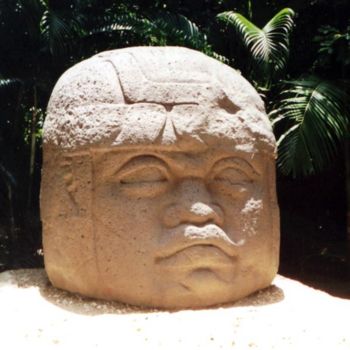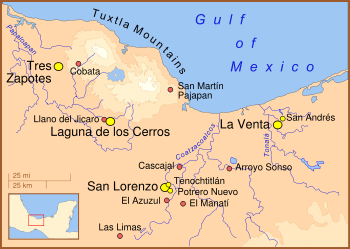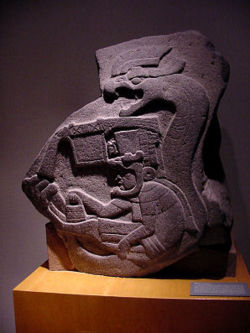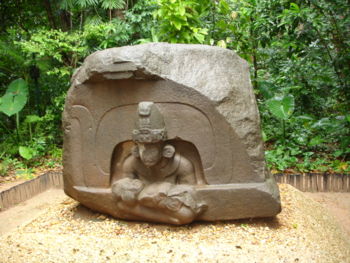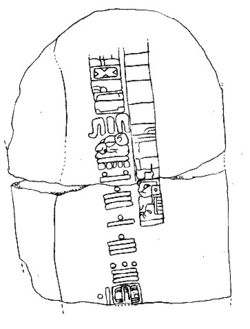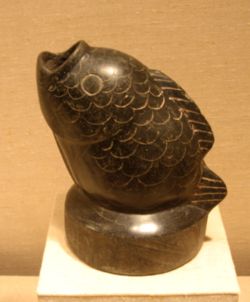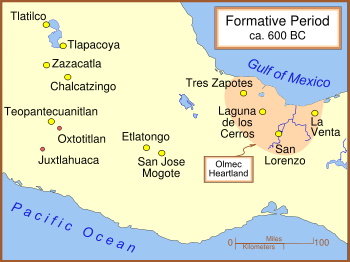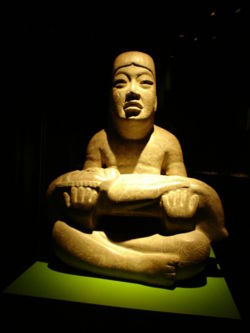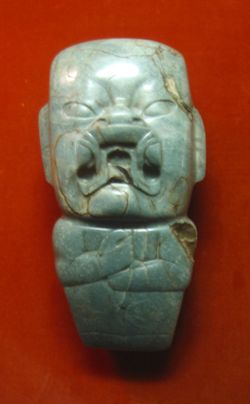Olmec
2008/9 Schools Wikipedia Selection. Related subjects: Ancient History, Classical History and Mythology
The Olmec were an ancient Pre-Columbian people living in the tropical lowlands of south-central Mexico, roughly in what are the modern-day states of Veracruz and Tabasco on the Isthmus of Tehuantepec. Their cultural influence, however, extends far beyond this region. The Olmec flourished during the Formative (or Preclassic) period, dating from 1400 BCE to about 400 BCE, and are believed to have been the progenitor civilization of later Mesoamerican civilizations.
Overview
The Olmec heartland is characterized by swampy lowlands punctuated by low hills, ridges, and volcanoes. The Tuxtlas Mountains rise sharply in the north, along the Gulf of Mexico's Bay of Campeche. Here the Olmecs constructed permanent city-temple complexes at several locations, among them San Lorenzo Tenochtitlán, La Venta, Tres Zapotes, and Laguna de los Cerros. In this heartland, the first Mesoamerican civilization would emerge and reign from 1200–400 BCE.
Early history
Olmec history originated at its base within San Lorenzo Tenochtitlán, where distinctively Olmec features begin to emerge before 1200 BCE. The rise of civilization here was probably assisted by the local ecology of well-watered rich alluvial soil, encouraging high maize production. This ecology may be compared to that of other ancient centers of civilization: the Nile, Indus, and Yellow River valleys, and Mesopotamia. It is thought that the dense population concentration at San Lorenzo encouraged the rise of an elite class that eventually ensured Olmec dominance and provided the social basis for the production of the symbolic and sophisticated luxury artifacts that define Olmec culture. Many of these luxury artifacts, such as jade, obsidian and magnetite, came from distant locations and suggest that early Olmec elites had access to an extensive trading network in Mesoamerica. The source of the most valued jade, for example, is found in the Motagua River valley in eastern Guatemala, and their obsidian is mainly from sources also in the Guatemala highlands, such as El Chayal and San Martín Jilotepeque.
La Venta
The first Olmec centre, San Lorenzo, was all but abandoned around 900 BCE at about the same time that La Venta rose to prominence. Environmental changes may have been responsible for this move, with certain important rivers changing course. A wholesale destruction of many San Lorenzo monuments also occurred around this time, circa 950 BCE, which may point to an internal uprising or, less likely, an invasion. Following the decline of San Lorenzo, La Venta became the most prominent Olmec centre, lasting from 900 BCE until its abandonment around 400 BCE. During this period, the Great Pyramid and various other ceremonial complexes were built at La Venta.
Decline
It is not known with any clarity what caused the eventual extinction of the Olmec culture. It is known that between 400 and 350 BCE, population in the eastern half of the Olmec heartland dropped precipitously, and the area would remain sparsely inhabited until the 19th century. This depopulation was likely the result of environmental changes: perhaps the result of important rivers changing course or silting up due to agricultural practices.
What ever the cause, within a few hundred years of the abandonment of the last Olmec cities, successor cultures had become firmly established. The Tres Zapotes site, on the western edge of the Olmec heartland, continued to be occupied well past 400 BCE, but without the hallmarks of the Olmec culture. This post-Olmec culture, often labeled Epi-Olmec, has features similar to those found at Izapa, some 330 miles (550 km) to the southeast.
Notable innovations
As the first civilization in Mesoamerica, the Olmecs are credited, or speculatively credited, with many "firsts", including the Mesoamerican ballgame, bloodletting and perhaps human sacrifice, writing and epigraphy, and the invention of zero and the Mesoamerican calendar. Their political arrangements of strongly hierarchical city-states were repeated by nearly every other Mexican and Central American civilization that followed. Some researchers, including artist and art historian Miguel Covarrubias, even postulate that the Olmecs formulated the forerunners of many of the later Mesoamerican deities.
Bloodletting and sacrifice
There is a strong case that the Olmecs practiced bloodletting, or autosacrifice. Numerous natural and ceramic stingray spikes and maguey thorns have been found in the archaeological record of the Olmec heartland.
The argument that the Olmecs instituted human sacrifice is significantly more speculative. No Olmec or Olmec-influenced sacrificial artifacts have yet been discovered and there is no Olmec or Olmec-influenced artwork that unambiguously shows sacrificial victims (similar, for example, to the danzante figures of Monte Albán) or scenes of human sacrifice (such as can be seen in the famous ballcourt mural from El Tajin).
However, at the El Manatí site, disarticulated skulls and femurs as well as complete skeletons of newborn or unborn children have been discovered amidst the other offerings, leading to speculation concerning infant sacrifice. It is not yet known, though, how the infants met their deaths. Some authors have also associated infant sacrifice with Olmec ritual art showing limp " were-jaguar" babies, most famously in La Venta's Altar 5 (to the left) or Las Limas figure (see Religion below). Definitive answers will need to await further findings.
Writing
The Olmec may have been the first civilization in the Western Hemisphere to develop a writing system. Symbols found in 2002 and 2006 date to 650 BCE and 900 BCE respectively, preceding the oldest Zapotec writing dated to about 500 BCE.
The 2002 find at the San Andrés site shows a bird, speech scrolls, and glyphs that are similar to the later Mayan hieroglyphs.
Known as the Cascajal Block, the 2006 find from a site near San Lorenzo, shows a set of 62 symbols, 28 of which are unique, carved on a serpentine block. A large number of prominent archaeologists have hailed this find as the "earliest pre-Columbian writing". Others are skeptical because of the stone's singularity, the fact that it had been removed from any archaeological context, and because it bears no apparent resemblance to any other Mesoamerican writing system.
There are also well-documented later hieroglyphs known as " Epi-Olmec", and while there are some who believe that Epi-Olmec may represent a transitional script between an earlier Olmec writing system and Maya writing, the matter remains unsettled.
Compass
Based on his find of an Olmec hematite artifact in Central America, the American astronomer John Carlson has suggested that "the Olmec may have discovered and used the geomagnetic lodestone compass earlier than 1000 BC". If true, this "predates the Chinese discovery of the geomagnetic lodestone compass by more than a millennium". Carlson speculates that the Olmecs may have used similar artifacts as a directional device for astrological or geomantic purposes, or to orientate their temples, the dwellings of the living or the interments of the dead.
The artifact itself is part of a lodestone that had been polished into a bar with a groove at one end (that Carlson suggests may have been used for sighting). The artifact now consistently points 35.5 degrees west of north, but may have pointed north-south when whole. It is possible that the artifact was in fact used as some constituent piece of a decorative ornament. No other similar hematite artifacts have yet been found.
Mesoamerican Long Count calendar & invention of the zero concept
The Long Count calendar used by many subsequent Mesoamerican civilizations, as well as the concept of zero, may have been devised by the Olmecs. Because the six artifacts with the earliest Long Count calendar dates were all discovered outside the immediate Maya homeland, it is likely that this calendar predated the Maya and was possibly the invention of the Olmecs. Indeed, three of these six artifacts were found within the Olmec heartland area. But an argument against an Olmec origin is the fact that the Olmec civilization had ended by the 4th century BCE, several centuries before the earliest known Long Count date artifact.
The Long Count calendar required the use of zero as a place-holder within its vigesimal (base-20) positional numeral system. A shell glyph —![]() — was used as a zero symbol for these Long Count dates, the second oldest of which, on Stela C at Tres Zapotes, has a date of 32 BCE. This is one of the earliest uses of the zero concept in history.
— was used as a zero symbol for these Long Count dates, the second oldest of which, on Stela C at Tres Zapotes, has a date of 32 BCE. This is one of the earliest uses of the zero concept in history.
Mesoamerican ballgame
The Olmec, whose name means "rubber people" in the Nahuatl language of the Aztecs (see below), are strong candidates for originating the Mesoamerican ballgame so prevalent among later cultures of the region and used for recreational and religious purposes. A dozen rubber balls dating to 1600 BCE or earlier have been found in El Manatí, an Olmec sacrificial bog 10 kilometres east of San Lorenzo Tenochtitlan. These balls predate the earliest ballcourt yet discovered at Paso de la Amada, circa 1400 BCE. The fact that the balls were found with other sacrificial items, including pottery and jadeite celts indicates that even at this early date, the ballgame had religious and ritual connotations.
Art
Olmec artforms remain in works of both monumental statuary and small jadework. Much Olmec art is highly stylized and uses an iconography reflective of a religious meaning. Some Olmec art, however, is surprisingly naturalistic, displaying an accuracy of human anatomy perhaps equaled in the pre-Columbian New World only by the best Maya Classic era art. Common motifs include downturned mouths and slit-like slanting eyes, both of which are seen as representations of " were-jaguars".
In addition to human subjects, Olmec artisans were adept at animal portrayals, for example, the fish vessel to the right or the bird vessel in the gallery below.
While Olmec figurines are found abundantly in sites throughout the Formative Period, it is the stone monuments such as the colossal heads that are the hallmarks of Olmec culture. These monuments can be divided into four classes:
- Colossal heads
- Rectangular "altars" or, more likely, thrones such as Altar 5 shown above.
- Free-standing in-the-round sculpture, such as the twins from El Azuzul or San Martin Pajapan Monument 1.
- Stelae, such as La Venta Monument 19 above. These types of monuments were generally created later than the colossal heads, altars, or free-standing sculptures. Over time they moved from simple representation of figures, such as Monument 19 or La Venta Stela 1, toward representations of historical events, particularly acts legitimizing rulers. This trend would culminate in post-Olmec monuments such as La Mojarra Stela 1, which combines images of rulers with script and calendar dates.
Colossal heads
The best-recognized aspect of the Olmec civilzation are the enormous helmeted heads. As no known pre-Columbian text explains these, these impressive monuments have been the subject of much speculation. Once theorized to be ballplayers, it is now generally accepted that these heads are portraits of rulers. According to archaeologist David Grove, the unique elements in the headgear can also be recognized in headdresses of human figures on other Gulf Coast monuments, suggesting that these are personal or group symbols.
There have been 17 colossal heads unearthed to date.
| Site | Count | Designations |
|---|---|---|
| San Lorenzo | 10 | Colossal Heads 1 through 10 |
| La Venta | 4 | Monuments 1 through 4 |
| Tres Zapotes | 2 | Monuments A & Q |
| Rancho la Cobata | 1 | Monument 1 |
The heads range in size from the Rancho La Cobata head, at 3.4 m high, to the pair at Tres Zapotes, at 1.47 m. It has been calculated that the largest heads weigh more than 20 tons.
The heads were carved from single blocks or boulders of volcanic basalt, found in the Tuxtlas Mountains. The Tres Zapotes heads were sculpted from basalt found at the summit of Cerro el Vigía, at the eastern end of the Tuxtlas. The San Lorenzo and La Venta heads, on the other hand, were likely carved from the basalt of Cerro Cintepec, on the southeastern side, perhaps at the nearby Llano del Jicaro workshop, and dragged or floated to their final destination. It has been estimated that moving a colossal head required the efforts of 1,500 people for three to four months.
Some of the heads, and many other monuments, have been variously mutilated, buried and disinterred, reset in new locations and/or reburied. It is known that some monuments, and at least two heads, were recycled or recarved, but it is not known whether this was simply due to the scarcity of stone or whether these actions had ritual or other connotations. It is also suspected that some mutilation had significance beyond mere destruction, but some scholars still do not rule out internal conflicts or, less likely, invasion as a factor.
The flat-faced, thick-lipped characteristics of the heads have caused some debate due to their apparent resemblance to African facial characteristics. Based on this comparison, some have insisted that the Olmecs were Africans who had emigrated to the New World. However, mainstream Mesoamerican scholars now reject this view, and offer other possible explanations for the facial features of the colossal heads, for example, that the heads were carved in this manner due to the shallow space allowed on the basalt boulders. Others note that in addition to the broad noses and thick lips, the heads have the Asian eye-fold, and that all these characteristics can still be found in modern Mesoamerican Indians. To support this, in the 1940s artist/art historian Miguel Covarrubias published a series of photos of Olmec artworks and of the faces of modern Mexican Indians with very similar facial characteristics.
Beyond the heartland
Olmec-style artifacts, designs, figurines, monuments and iconography have been found in the archaeological records of sites hundreds of kilometres outside the Olmec heartland. These sites include:
- Tlatilco and Tlapacoya, major centers of the Tlatilco culture in the Valley of Mexico, where artifacts include hollow baby-face motif figurines and Olmec designs on ceramics.
- Chalcatzingo, in Valley of Morelos, which features Olmec-style monumental art and rock art with Olmec-style figures.
- Teopantecuanitlan, in Guerrero, which features Olmec-style monumental art as well as city plans with distinctive Olmec features.
Other sites showing probable Olmec influence include Abaj Takalik in Guatemala and Zazacatla in Morelos. The Juxtlahuaca and Oxtotitlan cave paintings are attributed by most researchers to the Olmecs.
Many theories have been advanced to account for the occurrence of Olmec influence far outside the heartland, including long-range trade by Olmec merchants, Olmec colonization of other regions, Olmec artisans travelling to other cities, conscious imitation of Olmec artistical styles by developing towns – some even suggest the prospect of Olmec military domination outside of their heartland or that the Olmec iconography was actually developed outside the heartland.
The generally accepted, but by no means unanimous, interpretation is that the Olmec-style artifacts, in all sizes, became associated with elite status and were adopted by non-Olmec Formative Period chieftains in an effort to bolster their status.
Daily life
Ethnicity and language
While the actual ethnicity of the Olmec remains unknown, various hypotheses have been put forward. In 1976 Lyle Campbell and Terrence Kaufman published a paper which argued that there are a core number of loanwords which have apparently spread from a Mixe-Zoquean language into many other Mesoamerican languages. Campbell and Kaufman go on to argue that these core loanwords can be seen as an indicator that the Olmecs, the first "highly civilized society" of Mesoamerica, spoke a language which is an ancestor of the Mixe-Zoquean languages, and that they spread a vocabulary particular to their culture to the other peoples of Mesoamerica.
Since the Mixe-Zoquean languages still are, and historically are known to have been, spoken in an area corresponding roughly to the Olmec heartland, and since the Olmec culture is now generally regarded as the first "high culture" of Mesoamerica, it has generally been regarded as probable that the Olmec spoke a Mixe-Zoquean language.
Religion and mythology
Olmec religious activities were performed by a combination of rulers, full-time priests, and shamans. The rulers were probably the most important religious figures, with their links to the Olmec deities or supernaturals providing legitimacy for their rule. There is also considerable evidence for shamans in the Olmec archaeological record, particularly in the so-called " transformation figurines".
Olmec mythology has left no documents comparable to the Popul Vuh from Maya mythology, and therefore any exposition of Olmec mythology must rely on interpretations of surviving monumental and portable art (such as the Las Limas figure at top right), and comparisons with other Mesoamerican mythologies. Olmec art shows that such deities as the Feathered Serpent and the Rain Spirit were already in the Mesoamerican pantheon in Olmec times.
Social and political organization
Little is directly known about the societal or political structure of Olmec society. Although it is assumed by most researchers that the colossal heads and several other sculptures represent rulers, we have nothing like the Maya stelae ( see drawing) which name specific rulers and provide the dates of their rule.
Instead, archaeologists have relied on the data that they do have, such as large- and small-scale site surveys. There is considerable centralization within the Olmec heartland, first at San Lorenzo and then at La Venta. No other Olmec heartland site comes close to these in terms of size or in quantity and quality of architecture and sculpture. Diehl, for example, refers to San Lorenzo and La Venta as "Regal-Ritual Cities".
This demographic centralization leads archaeologists to propose that in general Olmec society was also highly centralized, with a strongly hierarchial structure, concentrated first at San Lorenzo and then at La Venta, with an elite that was able to use their control over materials such as monumental stone and water to exert command and legitimize their regime.
Even during their heydey, however, it is doubtful that San Lorenzo or La Venta controlled all of the Olmec heartland, despite their size. There is some doubt, for example, that La Venta controlled Arroyo Sonso, only some 35 km away. Studies of the Tuxtla Mountain settlements, some 60 km away, indicate that this area was composed of more or less egalitarian communities outside the control of lowland centers.
Village life and diet
Despite their size, San Lorenzo and La Venta were largely ceremonial centers, and the vast majority of the Olmec lived in villages similar to present-day villages and hamlets in Tabasco and Veracruz.
These villages were located on higher ground and consisted of several scattered houses. A modest temple may have been associated with the larger villages. The individual dwellings would consist of a house, an associated lean-to, and one or more storage pits (similar in function to a root cellar). A nearby garden was used for medicinal and cooking herbs and for smaller crops such as the domesticated sunflower. Fruit trees, such as avocado or cacao, were likely available nearby.
Although the river banks were used to plant crops between flooding periods, the Olmecs also likely practiced swidden (or slash-and-burn) agriculture to clear the forests and shrubs, and to provide new fields once the old fields were exhausted. Fields were located outside the village, and were used for maize, beans, squash, manioc, sweet potato, as well as cotton. Based on studies of two villages in the Tuxtlas Mountains, it is known that maize cultivation became increasingly important to the Olmec diet over time, although the diet remained fairly diverse.
The fruits and vegetables were supplemented with fish, turtle, snake, and mollusks from the nearby rivers, and crabs and shellfish in the coastal areas.
Birds were available as food sources, as were game including peccary, oppossum, raccoon, rabbit, and in particular deer. Despite the wide range of hunting and fishing available, midden surveys in San Lorenzo have found that the domesticated dog was the single most plentiful source of animal protein.
History of scholarly research
Olmec culture was unknown to historians until the mid-19th century. In 1862 the fortuitous discovery of a colossal head near Tres Zapotes, Veracruz by José Melgar y Serrano marked the first significant rediscovery of Olmec artifacts. In the latter half of the 19th century, Olmec artifacts such as the Kunz Axe (right) came to light and were recognized as belonging to a unique artistic tradition.
Frans Blom and Oliver La Farge made the first detailed descriptions of La Venta and San Martin Pajapan Monument 1 during their 1925 expedition. However, at this time most archaeologists assumed the Olmec were contemporaneous with the Maya – even Blom and La Farge were, in their own words, "inclined to ascribe them to the Maya culture"..
Matthew Stirling of the Smithsonian Institution conducted the first detailed scientific excavations of Olmec sites in the 1930s and 1940s. Stirling, along with art historian Miguel Covarrubias, became convinced that the Olmec predated most other known Mesoamerican civilizations.
In counterpoint to Stirling, Covarrubias, and Alfonso Caso, however, Mayanists Eric Thompson and Sylvanus Morley argued for Classic era dates for the Olmec artifacts. The question of Olmec chronology came to a head at a 1942 Tuxtla Gutierrez conference, where Alfonso Caso declared that the Olmecs were the "mother culture" ("cultura madre") of Mesoamerica.
Shortly after the conference, radiocarbon dating proved the antiquity of the Olmec civilization, although the "mother culture" question generates much debate even 60 years later.
Etymology
The name "Olmec" means "rubber people" in Nahuatl, the language of the Aztec, and was the Aztec name for the people who lived in the area of the Olmec heartland in the 15th and 16th centuries, some 2000 years after what we know as the Olmec culture died out. The term "rubber people" refers to the ancient practice, spanning from ancient Olmecs to Aztecs, of extracting latex from Castilla elastica, a rubber tree in the area. The juice of a local vine, Ipomoea alba, was then mixed with this latex to create rubber as early as 1600 BCE.
Early modern explorers and archaeologists, however, mistakenly applied the name "Olmec" to the rediscovered ruins and artifacts in the heartland decades before it was understood that these were not created by people the Aztecs knew as the "Olmec", but rather a culture that was 2000 years older. Despite the mistaken identity, the name has stuck.
It is not known what name the ancient Olmec used for themselves; some later Mesoamerican accounts seem to refer to the ancient Olmec as " Tamoanchan". Another term sometimes used to describe the Olmec culture is tenocelome, meaning "mouth of the jaguar".
Alternative origin speculations
In part because the Olmecs developed the first Mesoamerican civilization and in part because so little is known of the Olmecs (relative, for example, to the Maya or Aztec), a wide number of Olmec alternative origin speculations have been put forth. Although several of these speculations, particularly the theory that the Olmecs were of African origin, have become well-known within popular culture, popularized by Ivan van Sertima's book They Came Before Columbus, they are not considered credible by the vast majority of Mesoamerican researchers.
